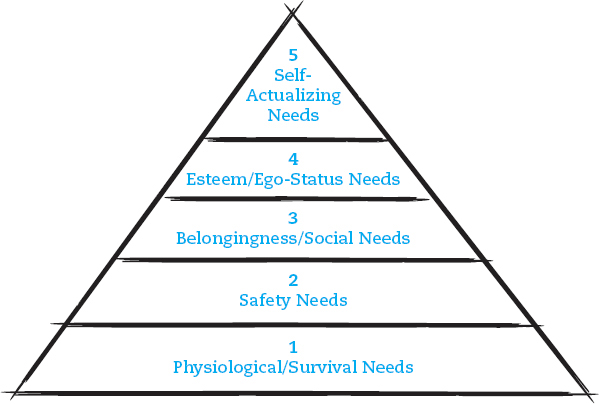Understanding Your Audience’s Needs
Understanding Your Audience’s Needs
Page 340
If you feel that your child isn’t getting sufficient or proper instruction in mathematics, you probably aren’t going to be too interested in hearing a speech on the importance of raising money for new school football uniforms. That’s because that topic doesn’t address your personal needs, or deficits that create tension. Helpful to understanding audience needs is the work of Abraham Maslow (1954). Maslow argues that an individual’s motivations, priorities, and behavior are influenced primarily by that person’s needs. He identifies needs in a hierarchical structure of five categories (see Figure 15.1 on p. 341), from low (immature) to high (mature), known as the hierarchy of needs.1
The theory is that the most basic needs must be met before an individual can become concerned with needs farther up in the hierarchy.
- Physiological/survival needs. These are the things you need for basic survival, such as air, water, food, shelter, sleep, clothing, and so on. Even in the short term, if you listen to a speech while you are very hungry, your mind is likely not on the message but rather on getting food.
- Safety needs. These are needs for security, orderliness, protection, and risk avoidance. They include not only actual physical safety but safety from emotional injury as well. When people in a community are concerned with violence and crime, for example, they are less likely to listen to persuasive appeals to increase local arts funding.
- Belongingness/social needs. These needs center around your interactions with others. They include the desire to be accepted and liked by other people and the need for love, affection, and affiliation. These needs are normally met by family ties, friendships, and membership in work and social groups.
- Esteem/ego-status needs. These needs involve validation—being accepted by some group and being recognized for achievement, mastery, competence, and so on. They can be satisfied by special recognition, promotions, power, and achievement. Unlike the previous three categories, esteem needs are not satisfied internally; they require praise and acknowledgment from others.
- Self-actualizing needs. Needs at the highest level focus on personal development and self-fulfillment—becoming what you can become. Instead of looking for recognition of your worth from others, you seek to measure up to your own criteria for personal success.
If you understand your audience’s needs, you can determine your strategy for persuading your listeners. The message must target the unfulfilled need of the audience. A need that is already met will not move an audience, nor will one that seems too far out of reach in the hierarchy.
